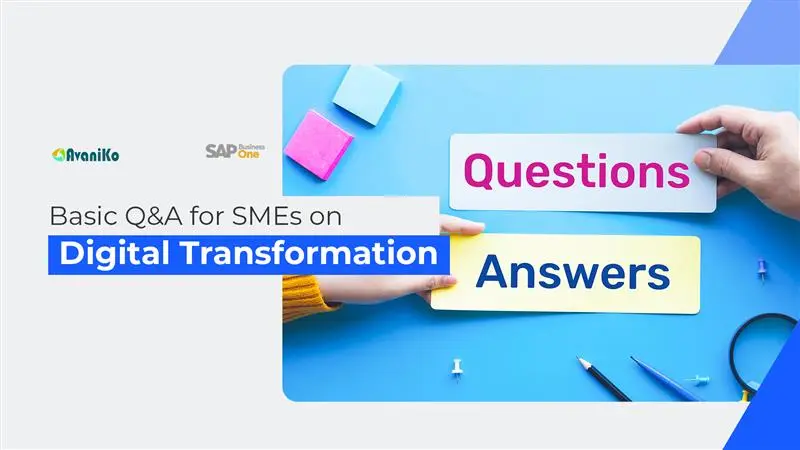Basic Q&A for SMEs on Digital Transformation

1. What is digital transformation?
Digital transformation involves using digital technologies to enhance your business’s operations, customer service, and competitiveness. It could be as simple as moving from paper records to cloud storage or automating your billing process.
2. Why should SMEs care about digital transformation?
Because it helps you save time, cut costs, reach more customers, and make faster, better decisions. Digital tools can give you an edge over competitors and improve customer satisfaction.
3. Is digital transformation only for big companies?
No! In fact, SMEs can benefit even more. Smaller teams are often more flexible and can adopt new tools quickly. Even basic steps—like using digital invoices or managing inventory online—can make a huge impact.
4. What are some easy first steps for my business?
• Switch to digital accounting and invoicing tools (e.g.,Zoho, QuickBooks)
• Utilize cloud storage services like Google Drive and Dropbox.
• Create a business profile online (Google, social media)
• Begin using a straightforward CRM program to keep track of leads and clients
5. How do I know which digital tools are right for me?
Start by identifying your biggest pain points manual billing, poor customer follow-up, or inventory errors. After that, look for tools that can address those issues. A consultant or IT partner can help, but many tools also offer free trial.
6. Is it expensive to go digital?
Not necessarily. Small businesses can benefit from affordable plans offered by many digital tools The return on investment is often high because you save time, avoid mistakes, and increase revenue.
7. What challenges should I expect?
• Resistance to change (especially from staff)
• Learning curves for new software
• Integration issues with existing processes
The key is to start small, train your team, and improve gradually.
8. What are the first steps to start digital transformation in an SME?
1. Evaluate your current processes – which ones are manual, repetitive, or susceptible to errors?
2. Define clear goals – Reduce cost, speed up delivery, improve customer support?
3. Prioritize quick wins – Start with tools like accounting software or CRM.
4. Train your team – Make sure employees understand and accept the changes.
5. Keep an eye on and modify- Observe results and gradually improve.
9. How can I make sure my team adopts the change?
• Communicate the benefits clearly
• Involve them in tool selection
• Offer training and ongoing support
• Celebrate small wins and improvements
10. What areas of my business can be digitally transformed?
• Accounting and finance
• Sales and CRM
• Marketing and social media
• Inventory and logistics
• Customer support
• HR and payroll
Even a single improvement—like online payment collection—can boost efficiency.
11. How do I measure the success of digital transformation?
Track metrics like:
• Time saved on tasks
• Customer satisfaction
• Sales growth
• Error reduction
• Faster response times
These help you see where you’re winning and where to improve further.
12. What are some digital tools that help with process optimization?
• ERP/CRM: Zoho, SAP B1, Salesforce
• Accounting & Invoicing: TallyPrime, QuickBooks
• HR & Payroll: Keka, greytHR
• Marketing: Mailchimp, Meta Ads, Canva
• Collaboration: Slack, Microsoft Teams, Google Workspace
13. What if an SME doesn’t start digital transformation?
• You may fall behind competitors who operate faster and cheaper.
• Manual errors and delays will increase the dissatisfaction of customers.
• Your team might struggle to collaborate, especially in hybrid/remote setups.
• You’ll lose out on valuable data-driven decisions.
• Scaling becomes difficult and costly.
In short: “No change” eventually becomes the most expensive decision.
14. What does the future of technology look like for SMEs?
• AI and Automation: Intelligent chatbots, auto-generated insights, and robotic process automation (RPA)
• Cloud Everything: Remote access to data, tools, and services
• Data-Driven Culture: Making decisions backed by analytics, not guesswork
• Cybersecurity: Affordable security tools for even small teams
• No-code/Low-code Platforms: Build your own apps without hiring developers
Early adopters will grow faster and serve customers better.
15. How can I make digital transformation sustainable in the long run?
• Keep it simple—start small and scale
• Stay customer-focused—improve their experience
• Measure ROI—track cost savings, faster deliveries, happier customers
• Review tech every 6–12 months to keep up with trends